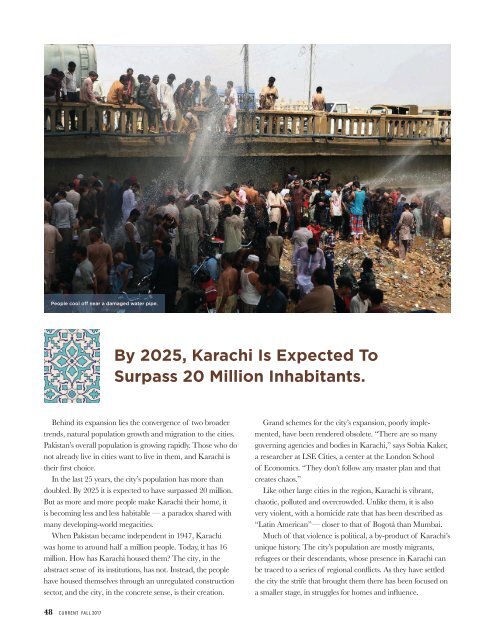Current Magazine
Create successful ePaper yourself
Turn your PDF publications into a flip-book with our unique Google optimized e-Paper software.
People cool off near a damaged water pipe.<br />
By 2025, Karachi Is Expected To<br />
Surpass 20 Million Inhabitants.<br />
Behind its expansion lies the convergence of two broader<br />
trends , natural population growth and migration to the cities.<br />
Pakistan’s overall population is growing rapidly. Those who do<br />
not already live in cities want to live in them, and Karachi is<br />
their first choice.<br />
In the last 25 years, the city’s population has more than<br />
doubled. By 2025 it is expected to have surpassed 20 million.<br />
But as more and more people make Karachi their home, it<br />
is becoming less and less habitable — a paradox shared with<br />
many developing-world megacities.<br />
When Pakistan became independent in 1947, Karachi<br />
was home to around half a million people. Today, it has 16<br />
million. How has Karachi housed them? The city , in the<br />
abstract sense of its institutions, has not. Instead, the people<br />
have housed themselves through an unregulated construction<br />
sector, and the city , in the concrete sense , is their creation.<br />
Grand schemes for the city’s expansion, poorly implemented,<br />
have been rendered obsolete. “There are so many<br />
governing agencies and bodies in Karachi,” says Sobia Kaker,<br />
a researcher at LSE Cities, a center at the London School<br />
of Economics. “They don’t follow any master plan and that<br />
creates chaos.”<br />
Like other large cities in the region, Karachi is vibrant,<br />
chaotic, polluted and overcrowded. Unlike them, it is also<br />
very violent, with a homicide rate that has been described as<br />
“Latin American” — closer to that of Bogotá than Mumbai.<br />
Much of that violence is political, a by-product of Karachi’s<br />
unique history. The city’s population are mostly migrants,<br />
refugees or their descendants, whose presence in Karachi can<br />
be traced to a series of regional conflicts. As they have settled<br />
the city the strife that brought them there has been focused on<br />
a smaller stage, in struggles for homes and influence.<br />
48 CURRENT FALL 2017





